
Matteuccia is a genus of ferns with one species: Matteuccia struthiopteris. The species epithet struthiopteris comes from Ancient Greek words στρουθίων (strouthíōn) "ostrich" and πτερίς (pterís) "fern".

Dryopteris, commonly called the wood ferns, male ferns, or buckler ferns, is a fern genus in the family Dryopteridaceae, subfamily Dryopteridoideae, according to the Pteridophyte Phylogeny Group classification of 2016 (PPG I). There are about 300-400 species in the genus. The species are distributed in Asia, the Americas, Europe, Africa, and the Pacific islands, with the highest diversity in eastern Asia. It is placed in the family Dryopteridaceae, subfamily Dryopteridoideae, according to the Pteridophyte Phylogeny Group classification of 2016 (PPG I). Many of the species have stout, slowly creeping rootstocks that form a crown, with a vase-like ring of fronds. The sori are round, with a peltate indusium. The stipes have prominent scales.

The Dryopteridaceae are a family of leptosporangiate ferns in the order Polypodiales. They are known colloquially as the wood ferns. In the Pteridophyte Phylogeny Group classification of 2016 (PPG I), the family is placed in the suborder Polypodiineae. Alternatively, it may be treated as the subfamily Dryopteridoideae of a very broadly defined family Polypodiaceae sensu lato.
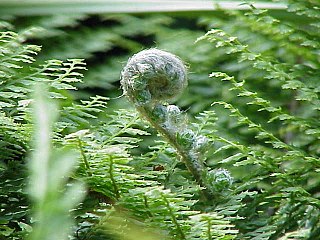
Polystichum is a genus of ferns in the family Dryopteridaceae, subfamily Dryopteridoideae, according to the Pteridophyte Phylogeny Group classification of 2016. The genus has about 500 species and has a cosmopolitan distribution. The highest diversity is in eastern Asia, with about 208 species in China alone; the region from Mexico to Brazil has at least 100 additional species; Africa, North America, and Europe have much lower diversity. Polystichum species are terrestrial or rock-dwelling ferns of warm-temperate and montane-tropical regions. They are often found in disturbed habitats such as road cuts, talus slopes, and stream banks.

Carl Ernst Otto Kuntze was a German botanist.

Dryopteris erythrosora, the autumn fern or Japanese shield fern, is a species of fern in the family Dryopteridaceae, native to east Asia from China and Japan south to the Philippines, growing in light woodland shade on low mountains or hills.

Acanthospermum is a genus of plants in the family Asteraceae, also known as starburrs or starburs. It was described as a genus in 1820.
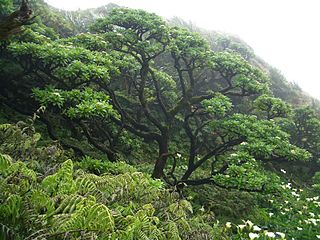
The flora of Saint Helena, an isolated island in the South Atlantic Ocean, is exceptional in its high level of endemism and the severe threats facing the survival of the flora. In phytogeography, it is in the phytochorion St. Helena and Ascension Region of the African Subkingdom, in the Paleotropical Kingdom.
Dryopteris hasseltii is a species of fern in the family Dryopteridaceae. It occurs from India, through southeast Asia, as far as north-east Queensland in Australia. Its natural habitat is subtropical or tropical moist lowland forests. It is threatened by habitat loss.
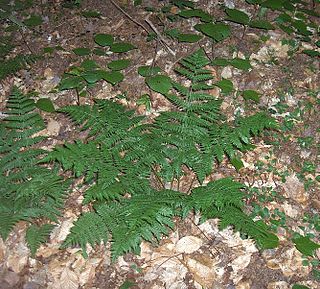
Dryopteris intermedia, the intermediate wood fern or evergreen wood fern, is a perennial, evergreen wood fern native to eastern North America. It is a diploid species, and is the parent of several species of hybrid origin, including Dryopteris carthusiana. Other common names for this species include intermediate shield fern, fancy wood fern, fancy fern, glandular wood fern, American shield fern and common wood fern.
Dryopteris shibpedis is a species of fern native Japan that was declared extinct in 2007, that has since been rediscovered in the Tsukuba Botanical Garden. Despite rediscovery, D. shibipedis is still ranked as extinct in the wild.

Dryopteris cycadina, the shaggy shield fern or black wood fern, is a species of deciduous or semi-evergreen fern in the family Dryopteridaceae, native to northern India, China, Taiwan and Japan. It grows to 60 cm (24 in) tall by 45 cm (18 in) wide, and produces pale green fronds maturing to dark green, on erect rhizomes.
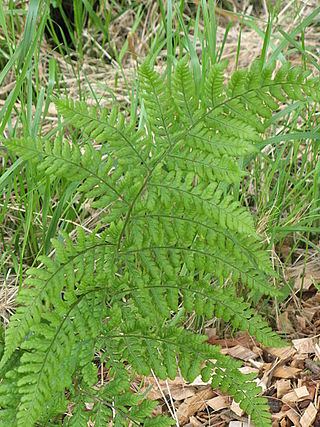
Dryopteris dilatata, the broad buckler-fern, is a robust species of deciduous or semievergreen fern in the family Dryopteridaceae, native to Europe, particularly western and central Europe. In southern Europe, it is mostly found in mountainous regions. It is also found between the Black Sea and the Caspian Sea. It grows to 90 cm (35 in) tall by 120 cm (47 in) wide, with dark green tripinnate fronds, the ribs covered in brown scales.

Dryopteris wallichiana, the alpine wood fern, is a robust species of deciduous or semi-evergreen fern in the family Dryopteridaceae, native to the Himalayas, Hawaii, Mexico and Jamaica. It grows to 90 cm (35 in) tall, occasionally 180 cm (71 in) by 75 cm (30 in) wide, with pale green tripinnate fronds, strongly contrasting with the dark brown ribs.

Dryopteris crassirhizoma is a fern species in the wood fern family Dryopteridaceae.
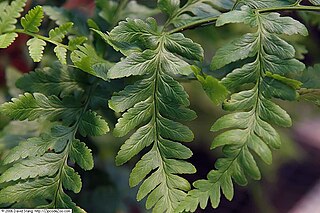
Dryopteris celsa, the log fern, is a perennial fern in the family Dryopteridaceae. It naturally occurs on rotting logs and the rich soil of swamps and wet woodlands. Its native range includes the southeastern United States.
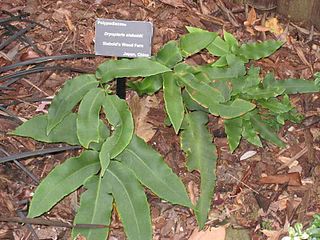
Dryopteris sieboldii is a species of fern in the family Dryopteridaceae, native to Japan and south-central and southeast China. It has gained the Royal Horticultural Society's Award of Garden Merit as an ornamental.
Elaphoglossum nervosum, the veined tongue-fern, is a herbaceous plant, a member of the Dryopteridaceae family.
Elaphoglossum dimorphum, the toothed tongue-fern, is a herbaceous plant, a member of the Dryopteridaceae family.

Dryopteris varia is a species of fern in the family Dryopteridaceae.
















